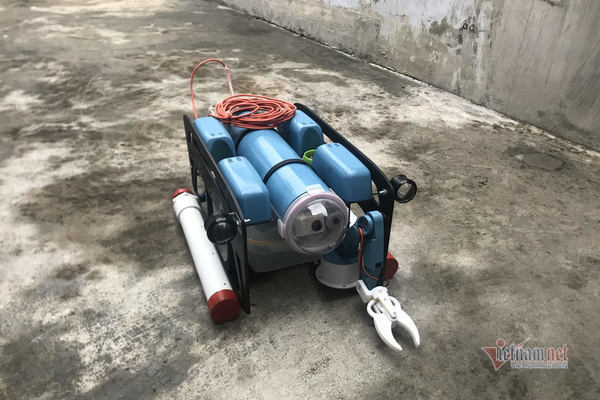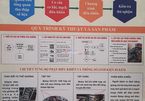
Lan's submarine robot
His latest achievement is second prize in the National Science and Technology Competition for high school students for his submarine robot that supports hydrogeological research.
Lan decided to work on the robot after learning about problems that hinder undersea research of specimens. With the desire to reduce risks when people carry out research deep under the sea, Lan set to work on a submarine robot.
He spent all his time after school hours on his project. After eight months, he successfully assembled the robot which brought him first prize in the province and second prize at the national competition.
The robot weighs 20 kilograms and can dive at the depth of 50 meters. It supports image data collection, 3D map drawing, and seabed topography with a photogrammetric method combined with a vision tool.
It also recognizes objects with AI, operates them with spectral cameras, and monitors water environmental parameters with a sensor system.
The robot arm helps collect specimens when necessary, and has a part that collects liquid for research.
The system operates automatically under a preset roadmap with pre-installed points on the map and then returns to the starting position. Users monitor the robot and operate it remotely via a phone app or computer.
All the engine, IC system and components of the robot were imported at a cost of VND15 million, according to Lan.
Asked about the problems when designing the robot, Lan said that electronic parts were easily damaged in the water environment. Lan tried many different assembly methods to solve the problem.
In fact, new problems arose every time during experimentation. However, the difficulties made him more determined. The student finished all exercises in class so that he could spend time at home on research.
“After every failure, I came up with new ideas, better than the previous ones,” he said.
The diving mechanism, for example, uses a diving engine to force the ship down instead of pumping water into the compartment, which can make it heavier and sink. His plan increased the flexibility to help the operator easily access different difficult types of terrain under the sea.
However, the project is beyond the financial capability of a high school student, so the model cannot be examined in different conditions.
Ngoc Linh

20 universities in southern VN recruit students based on IELTS, int’l certificates
In 2021, about 20 universities in the southern region of Vietnam will enroll students based on their IELTS and international certifications.

Are the sci-tech competitions for high school students fair?
Some projects submitted at the national science and technology for high school students have surprised people as they have dealt with complicated issues such as treatment of cancer and stroke.